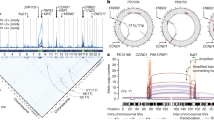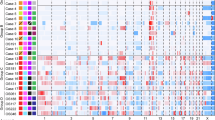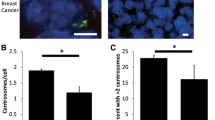Abstract
Chromosome locus 11q13 is frequently amplified in a number of human cancers including carcinoma of the breast where up to 15% carry this chromosomal abnormality. Originally 11q13 amplification was thought to involve a single amplicon spanning many megabases, but more recent data have identified four core regions within 11q13 that can be amplified independently or together in different combinations. Although the region harbors several genes with known or suspected oncogenic potential, the complex structure of the amplicons and the fact that 11q13 is gene-rich have made definitive identification of specific genes that contribute to the genesis and progression of breast cancer a difficult and continuing process. To date CCND1, encoding the cell cycle regulatory gene cyclin D1, and EMS1, encoding the filamentous actin binding protein and c-Src substrate cortactin, are the favored candidates responsible for the emergence of two of the four amplification cores.
Similar content being viewed by others
References
Teixeira MR, Pandis N, Heim S: Cytogenetic clues to breast carcinogenesis. Genes Chromosome Cancer 33: 1-16, 2002
Bieche I, Lidereau R: Genetic alterations in breast cancer. Genes Chromosome Cancer 14: 227-251, 1995
Karlseder J, Zeillinger R, Schneeberger C, Czerwenka K, Speiser P, Kubista E, Birnbaum D, Gaudray P, Theillet C: Patterns of DNA amplification at band q13 of chromosome 11 in human breast cancer. Genes Chromosome Cancer 9: 42-48, 1994
Hui R, Campbell DH, Lee CSL, McCaul K, Horsfall DJ, Musgrove EA, Daly RJ, Seshadri R, Sutherland RL: EMS1 amplification can occur independently of CCND1 or INT2 amplification at 11q13 and may identify different phenotypes in primary breast cancer. Oncogene 15: 1617-1623, 1997
Bekri S, Adelaide J, Merscher S, Grosgeorge J, Caroli BF, Perucca LD, Kelley PM, Pebusque MJ, Theillet C, Birnbaum D, Gaudray P: Detailed map of a region commonly amplified at 11q13?q14 in human breast carcinoma. Cytogenet Cell Genet 79: 125-131, 1997
Courjal F, Cuny M, Simony-Lafontaine J, Louason G, Speiser P, Zeillinger R, Rodriguez C, Theillet C: Mapping of DNA amplifications at 15 chromosomal localizations in 1875 breast tumors: definition of phenotypic groups. Cancer Res 57: 4360-4367, 1997
Adam L, Vadlamudi R, Kondapaka S, Chernoff J, Mendelsohn J, Kumar R: Heregulin regulates cytoskeletal reorganization and cell migration through the p21-activated kinase-1 via phosphatidylinositol-3 kinase. J Biol Chem 273: 28238-28246, 1998
Vadlamudi RK, Adam L, Wang R, Mandal M, Nguyen D, Sahin A, Chernoff J, Hung M, Kumar R: Regulatable expression of p21-activated kinase-1 promotes anchorageindependent growth and abnormal organization of mitotic spindles in human epithelial breast cancer cells. J Biol Chem 275: 36238-36244, 2000
Edwards PA, Hiby S, Papkoff J, Bradbury J: Hyperplasia of mouse mammary epithelium induced by expression of the Wnt-1 (int-1) oncogene in reconstituted mammary gland. Oncogene 7: 2041-2051, 1992
Bradbury JM, Niemeyer C, Dale T, Edwards P: Alterations of the growth characteristics of the fibroblast cell line C3H 10T1/2 by members of the Wnt gene family. Oncogene 9: 2597-2603, 1994
Bradbury JM, Edwards P, Niemeyer C, Dale T: Wnt-4 expression induces a pregnancy-like growth pattern in reconstituted mammary glands in virgin mice. Dev Biol 170: 553-563, 1995
Brisken C, Heineman A, Chavarria T, Elenbaas B, Tan J, Dey S, McMahon J, McMahon A, Weinberg R: Essential function of Wnt-4 in mammary gland development downstream of progesterone signaling. Genes Dev 14: 650-654, 2000
Naylor S, Smalley M, Robertson D, Gusterson B, Edwards P, Dale T: Retroviral expression of Wnt-1 and Wnt-7b produces different effects in mouse mammary epithelium. J Cell Sci 113: 2129-2138, 2000
Szepetowski P, Simon MP, Grosgeorge J, Huebner K, Bastard C, Evans GA, Tsujimoto Y, Birnbaum D, Theillet C, Gaudray P: Localization of 11q13 loci with respect to regional chromosomal breakpoints. Genomics 12: 738-744, 1992
Ormandy CJ, Lee CS, Ormandy HF, Fantl V, Shine J, Peters G, Sutherland RL: Amplification, expression, and steroid regulation of the preprogalanin gene in human breast cancer. Cancer Res 58: 1353-1357, 1998
Peters G, Brookes S, Smith R, Dickson C: Tumorigenesis by mouse mammary tumor virus: evidence for a common region for provirus integration in mammary tumors. Cell 33: 367-377, 1983
Lidereau R, Callahan R, Dickson C, Peters G, Escot C, Ali IU: Amplification of the int-2 gene in primary human breast tumors. Oncogene Res 2: 285-291, 1988
Zhou DJ, Casey G, Cline MJ: Amplification of human int-2 in breast cancers and squamous carcinomas. Oncogene 2: 279-282, 1988
Sakamoto H, Mori M, Taira M, Yoshida T, Matsukawa S, Shimizu K, Sekiguchi M, Terada M, Sugimura T: Transforming gene from human stomach cancers and a noncancerous portion of stomach mucosa. Proc Natl Acad Sci USA 83: 3997-4001, 1986
Delli Bovi P, Basilico C: Isolation of a rearranged human transforming gene following transfection of Kaposi sarcoma DNA. Proc Natl Acad Sci USA 84: 5660-5664, 1987
Delli Bovi P, Curatola AM, Kern FG, Greco A, Ittmann M, Basilico C: An oncogene isolated by transfection of Kaposi's sarcoma DNA encodes a growth factor that is a member of the FGF family. Cell 50: 729-737, 1987
Dickson C, Deed R, Dixon M, Peters G: The structure and function of the int-2 oncogene. Prog Growth Factor Res 1: 123-132, 1989
Fantl V, Richards MA, Smith R, Lammie GA, Johnstone G, Allen D, Gregory W, Peters G, Dickson C, Barnes DM: Gene amplification on chromosome band 11q13 and oestrogen receptor status in breast cancer. Eur J Cancer 26: 423-429, 1990
Schuuring E, Verhoeven E, van Tinteren H, Peterse JL, Nunnink B, Thunnissen FB, Devilee P, Cornelisse CJ, van de Vijver MJ, Mooi WJ, Michalides RJ: Amplification of genes within the chromosome 11q13 region is indicative of poor prognosis in patients with operable breast cancer. Cancer Res 52: 5229-5234, 1992
Tsuda T, Tahara E, Kajiyama G, Sakamoto H, Terada M, Sugimura T: High incidence of coamplification of hst-1 and int-2 genes in human esophageal carcinomas. Cancer Res 49: 5505-5508, 1989
Ladher R, Anakwe K, Gurney A, Schoenwolf G, Francis-West P: Identification of synergistic signals initiating inner ear development. Science 290: 1965-1967, 2000
Bautista S, Olivier M: CCND1 and FGFR1 coamplification results in the colocalization of 11q13 and 8p12 sequences in breast tumor nuclei. Genes Chromosome Cancer 22: 268-277, 1998
Cuny M, Kramar A, Courjal F, Johannsdottir V, Iacopetta B, Fontaine H, Grenier J, Culine S, Theillet C: Relating genotype and phenotype in breast cancer: an analysis of the prognostic significance of amplification at eight different genes or loci and of p53 mutations. Cancer Res 60: 1077-1083, 1999
Musgrove EA, Hamilton JA, Lee CS, Sweeney KJ, Watts CK, Sutherland RL: Growth factor, steroid, and steroid antagonist regulation of cyclin gene expression associated with changes in T-47D human breast cancer cell cycle progression. Mol Cell Biol 13: 3577-3587, 1993
Musgrove EA, Lee CS, Buckley MF, Sutherland RL: Cyclin D1 induction in breast cancer cells shortens G1 and is suffi-cient for cells arrested in G1 to complete the cell cycle. Proc Natl Acad Sci USA 91: 8022-8026, 1994
Quelle DE, Ashmun RA, Shurtleff SA, Kato JY, Bar-Sagi D, Roussel MF, Sherr CJ: Overexpression of mouse D-type cyclins accelerates G1 phase in rodent fibroblasts. Genes Dev 7: 1559-1571, 1993
Resnitzky D, Gossen M, Bujard H, Reed SI: Acceleration of the G1/S phase transition by expression of cyclins D1 and E with an inducible system. Mol Cell Biol 14: 1669-1679, 1994
Wang TC, Cardiff RD, Zukerberg L, Lees E, Arnold A, Schmidt EV: Mammary hyperplasia and carcinoma in MMTVcyclin D1 transgenic mice. Nature 369: 669-671, 1994
Fantl V, Stamp G, Andrews A, Rosewell I, Dickson C: Mice lacking cyclin D1 are small and show defects in eye and mammary gland development. Genes Dev 9: 2364-2372, 1995
Sicinski P, Donaher JL, Parker SB, Li T, Fazeli A, Gardner H, Haslam SZ, Bronson RT, Elledge SJ, Weinberg RA: Cyclin D1 provides a link between development and oncogenesis in the retina and breast. Cell 82: 621-630, 1995
Yu Q, Geng Y, Sicinski P: Specific protection against breast cancers by cyclin D1 ablation: Nature 411: 1017-1021, 2001
Said TK, Luo L, Medina D: Mouse mammary hyperplasias and neoplasias exhibit different patterns of cyclins D1 and D2 binding to cdk4. Carcinogenesis 16: 2507-2513, 1995
Hirai H, Sherr CJ: Interactions of D-type cyclins with a novel myb-like transcription factor, DMP1. Mol Cell Biol 16: 6457-6467, 1996
Inoue K, Sherr CJ: Gene expression and cell cycle arrest mediated by transcription factor DMP1 is antagonised by D-type cyclins through a cyclin-dependent-kinase-independent mechanism. Mol Cell Biol 18: 1590-1600, 1998
Bienvenu F, Gascan H, Coqueret O: Cyclin D1 represses STAT3 activation through a Cdk4-independent mechanism. J Biol Chem 276: 16840-16847, 2001
Knudsen KE, Cavenee WK, Arden KC: D-type cyclins complex with the androgen receptor and inhibit its transcriptional transactivation ability. Cancer Res 59: 2297-2301, 1999
Neuman E, Ladha MH, Lin N, Upton TM, Miller SJ, Direnzo J, Pestell RG, Hinds PW, Dowdy SF, Brown M, Ewen ME: Cyclin D1 stimulation of estrogen receptor transcriptional activity independent of cdk4. Mol Cell Biol 17: 5338-5347, 1997
Zwijsen RML, Wientjens E, Klompmaker R, van der Sman J, Bernards R, Michalides RJAM: CDK-independent activation of estrogen receptor by cyclin D1. Cell 88: 405-415, 1997
Geng Y, Yu Q, Sicinska E, Das M, Bronson RT, Sicinski P: Deletion of the p27Kip1 gene restores normal development in cyclin D1-deficient mice. Proc Natl Acad Sci USA 98: 194-199, 2001
Tong W, Pollard JW: Genetic evidence for the interactions of cyclin D1 and p27Kip1 in mice. Mol Cell Biol 21: 1319-1328, 2001
Sweeney KJ, Swarbrick A, Sutherland RL, Musgrove EA: Lack of relationship between CDK activity and G1 cyclin expression in breast cancer cells. Oncogene 16: 2865-2878, 1998
Zwicker J, Brusselbach S, Jooss KU, Sewing A, Behn M, Lucibello FC, Muller R: Functional domains in cyclin D1: pRb-kinase activity is not essential for transformation. Oncogene 18: 19-25, 1999
Buckley MF, Sweeney KJE, Hamilton JA, Sini RL, Manning DL, Nicholson RI, deFazio A, Watts CKW, Musgrove EA, Sutherland RL: Expression and amplification of cyclin genes in human breast cancer. Oncogene 8: 2127-2133, 1993
Bartkova J, Lukas J, Müller H, Lützhøft D, Strauss M, Bartek J: Cyclin D1 protein expression and function in human breast cancer. Int J Cancer 57: 353-361, 1994
Gillett C, Fantl V, Smith R, Fisher C, Bartek J, Dickson C, Barnes D, Peters G: Amplification and overexpression of cyclin D1 in breast cancer detected by immunohistochemical staining. Cancer Res 54: 1812-1817, 1994
Alle K, Henshall S, Field A, Sutherland R, Cyclin D1 protein is overexpressed in hyperplasia and intraductal carcinoma of the breast. Clin Can Res 4: 847-854, 1998
Weinstat-Saslow D, Merino M, Manrow R, Lawrence J, Bluth R, Wittenbel K, Simpson J, Page D, Steeg P: Overexpression of cyclin D mRNA distinguishes invasive and in situ breast carcinomas from non-malignant lesions. Nat Med 1: 1257-1260, 1995
Schuuring E, Verhoeven E, Mooi W, Michalides R: Identification and cloning of two overexpressed genes, U21B31/PRAD1 and EMS1 within the amplified chromosome 11q13 region in human carcinomas. Oncogene 7: 355-361, 1992
Hui R, Ball JR, Macmillan RD, Kenny FS, Prall OWJ, Campbell DH, Cornish AL, McClelland RA, Daly RJ, Forbes JF, Blamey RW, Musgrove EA, Robertson JFR, Nicholson RI, Sutherland RL: EMS1 gene expression in primary breast cancer: relationship to cyclin D1 and oestrogen receptor expression and patient survival. Oncogene 17: 1053-1059, 1998
Schuuring E, Vernoeven E, Litvinov S, Michalides RJAM: The product of the EMS1 gene, amplified and overexpressed in human carcinomas, is homologous to a v-src substrate and is located in cell-substratum contact sites. Mol Cell Biol 13: 2891-2898, 1993
Wu H, Reynolds AB, Kanner SB, Vines RR, Parsons JT: Identification and characterization of a novel cytoskeletonassociated pp60src substrate. Mol Cell Biol 11: 5113-5124, 1991
Weed SA, Karginov A, Schafer DA, Weaver AM, Kinley AW, Cooper JA, Parsons JT: Cortactin localization to sites of actin assembly in lamellipodia requires interactions with F-actin and the Arp2/3 complex. J Cell Biol 151: 29-40, 2000
Weed SA, Parsons JT: Cortactin: coupling membrane dynamics to cortical actin assembly. Oncogene 20: 6418-6434, 2001
Mizutani K, Miki H, He H, Maruta H, Takenawa T: Essential role of neural Wiskott-Aldrich syndrome protein in podosome formation and degradation of extracellular matrix in src-transformed fibroblasts. Cancer Res 62: 669-674, 2002
Uruno T, Liu J, Zhang P, Fan Y, Egile C, Li R, Mueller SC, Zhan X: Activation of Arp2/3 complex-mediated actin polymerization by cortactin. Nature Cell Biology 3: 259-266, 2001
Weaver AM, Karginov AV, Kinley AW, Weed SA, Li Y, Parsons JT, Cooper JA: Cortactin promotes and stabilizes Arp2/3-induced actin filament network formation. Curr Biol 11: 370-374, 2001
Patel AS, Schechter GL, Wasilenko WJ, Somers KD: Overexpression of EMS1/cortactin in NIH3T3 fibroblasts causes increased cell motility and invasion in vitro. Oncogene 16: 3227-3232, 1998
Huang C, Liu JL, Haudenschild CC, Zhan X: The role of tyrosine phosphorylation of cortactin in the locomotion of endothelial cells. J Biol Chem 273: 25770-25776, 1998
Bowden ET, Barth M, Thomas D, Glazer RI, Mueller SC: An invasion-related complex of cortactin, paxillin and PKCmu associates with invadopodia at sites of extracellular matrix degradation. Oncogene 18: 4440-4449, 1999
Li Y, Tondravi M, Liu J, Smith E, Haudenschild CC, Kaczmarek M, Zhan X: Cortactin potentiates bone metastasis of breast cancer cells. Cancer Res 61: 6906-6911, 2001
Du Y, Weed SA, Xiong W-C, Marshall TD, Parsons JT: Identification of a novel cortactin SH3 domain-binding protein and its localization to growth cones of cultured neurons. Mol Cell Biol 18: 5838-5851, 1998
Serra-Pages C, Medley QG, Tang M, Hart A, Streuli M: Liprins, a family of LAR transmembrane proteintyrosine phosphatase-interacting proteins. J Biol Chem 273: 15611-15620, 1998
Schaapveld RQ, Schepens JT, Robinson GW, Attema J, Oerlemans FT, Fransen JA, Streuli M, Wieringa B, Hennighausen L, Hendriks WJ: Impaired mammary gland development and function in mice lacking LAR receptor-like tyrosine phosphatase activity. Dev Biol 188: 134-146, 1997
Berns EM, Klijn JG, van Staveren IL, Portengen H, Noordegraaf E, Foekens JA: Prevalence of amplification of the oncogenes c-myc, HER2/neu, and int-2 in one thousand human breast tumours: correlation with steroid receptors. Eur J Cancer 28: 697-700, 1992
Fantl V, Smith R, Brookes S, Dickson C, Peters G: Chromosome 11q13 abnormalities in human breast cancer.Cancer Surv 18: 77-94, 1993
Berns E, Foekens J, van Staveren I, van Putten W, de Koning H, Portengen H, Klijn J: Oncogene amplification and prognosis in breast cancer: relationship with systemic treatment. Gene 159: 11-18, 1995
Borg A, Sigurdsson H, Clark GM, Ferno M, Fuqua SA, Olsson H, Killander D, McGurie WL: Association of INT2/HST1 coamplification in primary breast cancer with hormonedependent phenotype and poor prognosis. Br J Cancer 63: 136-142, 1991
Henry JA, Hennessy C, Levett DL, Lennard TW, Westley BR, May FE: int-2 amplification in breast cancer: association with decreased survival and relationship to amplification of c-erbB-2 and c-myc. Int J Cancer 53: 774-780, 1993
Schuuring E, Verhoeven E, van Tinteren H, Peterse J, Nunnink B, Thunnissen F, Devilee P, Cornelisse C, van de Vijver M, Mooi W, Michalides R: Amplification of genes within the 11q13 region is indicative of poor prognosis in patients with operable breast cancer. Cancer Res 52: 5229-5234, 1992
Seshadri R, Lee CSL, Hui R, McCaul K, Horsfall DJ, Sutherland RL: Cyclin D1 amplification is not associated with reduced overall survival in primary breast cancer but may predict early relapse in patients with features of good prognosis. Clin Cancer Res 2: 1177-1184, 1996
Tsuda H, Hirohashi S, Shimosato Y, Hirota T, Tsugane S, Yamamoto H, Miyajima N, Toyoshima K, Yamamoto T, Yokota J, Yoshida T, Sakamoto H, TeradaM, Sugimura T: Correlation between long-term survival in breast cancer patients and amplification of two putative oncogene-coamplification units: hst-1/int-2 and c-erbB-2/ear-1. Cancer Res 49: 3104-3108, 1989
Hui R, Cornish AL, McClelland RA, Robertson JFR, Blamey RW, Musgrove EA, Nicholson RI, Sutherland RL: Cyclin D1 and estrogen receptor mRNA expression are positively correlated in primary breast cancer. Clin Cancer Res 2: 923-928, 1996
Rodrigo JP, Garcia LA, Ramos S, Lazo PS, Suarez C: EMS1 gene amplification correlates with poor prognosis in squamous cell carcinomas of the head and neck. Clin Cancer Res 6: 3177-3182, 2000
Sainsbury JR, Farndon JR, Needham GK, Malcolm AJ, Harris AL: Epidermal-growth-factor receptor status as predictor of early recurrence of and death from breast cancer. Lancet i 1398-1402, 1987
Gullick WJ: The role of the epidermal growth factor receptor and the c-erbB-2 protein in breast cancer. Int J Cancer 5(suppl): 55-61,1990
Daly RJ: Take your partners, please-signal diversification by the erbB family of receptor tyrosine kinases. Growth Factors 16: 255-263, 1999
Huang C, Ni YS, Wang T, Gao YM, Haudenschild CC, Zhan X: Down-regulation of the filamentous actin cross-linking activity of cortactin by Src-mediated tyrosine phosphorylation. J Biol Chem 272: 13911-13915, 1997
Campbell DH, Sutherland RL, Daly RJ: Signaling pathways and structural domains required for phosphorylation of EMS1/cortactin. Cancer Res 59: 5376-5385, 1999
van Damme H, Brok H, Schuuring-Scholtes E, Schuuring E: The redistribution of cortactin into cell-matrix contact sites in human carcinoma cells with 11q13 amplification is associated with both overexpression and post-translational modification. J Biol Chem 272: 7374-7380, 1997
Author information
Authors and Affiliations
Rights and permissions
About this article
Cite this article
Ormandy, C.J., Musgrove, E.A., Hui, R. et al. Cyclin D1, EMS1 and 11q13 Amplification in Breast Cancer. Breast Cancer Res Treat 78, 323–335 (2003). https://doi.org/10.1023/A:1023033708204
Issue Date:
DOI: https://doi.org/10.1023/A:1023033708204




